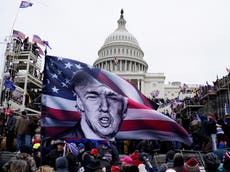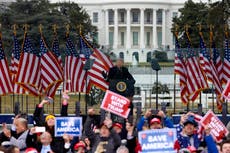‘A new kind of American radicalism’: Capitol rioters a mainstream movement ‘not connected to far-right extremism’
New breed of radicals – many from blue states – could be more dangerous than traditional far-right groups, report suggests
Your support helps us to tell the story
From reproductive rights to climate change to Big Tech, The Independent is on the ground when the story is developing. Whether it's investigating the financials of Elon Musk's pro-Trump PAC or producing our latest documentary, 'The A Word', which shines a light on the American women fighting for reproductive rights, we know how important it is to parse out the facts from the messaging.
At such a critical moment in US history, we need reporters on the ground. Your donation allows us to keep sending journalists to speak to both sides of the story.
The Independent is trusted by Americans across the entire political spectrum. And unlike many other quality news outlets, we choose not to lock Americans out of our reporting and analysis with paywalls. We believe quality journalism should be available to everyone, paid for by those who can afford it.
Your support makes all the difference.A University of Chicago analysis of 193 alleged Capitol rioters has found the large majority had no connection to far-right militias or white-nationalist gangs.
In stark contrast to right-wing political violence of previous years, researchers found that only 20 people arrested in connection to the Capitol were affiliated with groups like the Proud Boys, Oath Keepers and Three Percenters.
While attention has focused on the role of far-right groups, the data suggest the Capitol riots were driven by a new kind of radical; middle-aged, well educated, white-collar professionals from Democrat strongholds which voted for Joe Biden, like New York City and San Francisco.
In the previous five years from 2015 to 2020, almost half of suspected extremists arrested were members of groups like the Aryan Brotherhood, or part of a militia or organisation such as Oath Keepers and Three Percenters. And they were largely young, unemployed, blue-collar workers.
Only nine per cent of the alleged Capitol rioters studied were unemployed, compared to 61 per cent of earlier extremist suspects studied by the group that were unemployed.
In its report, The Face of American Insurrection, the team of 20 researchers from the university's Chicago Project on Security and Threat said the riots were not "merely a mix of right-wing organisations, but a broader mass movement with violence at its core".
Using methods the group previously deployed over the past 15 years to map the profile of Islamic State fighters and international terrorists, the group analysed more than 1,500 court documents, criminal complaints, statements of facts, affidavits, media reports and interviews to create a database of demographics and socioeconomic traits.
In an analysis of their findings, University of Chicago political science professor Robert Pape and Chicago Project on Security and Threats senior research associate Keven Ruby wrote in The Atlantic that the new American radical was potentially far more dangerous.
"A new kind of violent mass movement in which more ‘normal’ Trump supporters — middle-class and, in many cases, middle-aged people without obvious ties to the far right — joined with extremists in an attempt to overturn a presidential election," they wrote.
Having looked at who was connected to the riot, they also considered the why. According to their analysis, the overwhelming reason for action was Donald Trump's orders to prevent Congress certifying Mr Biden as president.
"The attack on the Capitol was unmistakably an act of political violence, not merely an exercise in vandalism or trespassing amid a disorderly protest that had spiralled out of control," they wrote.
Of those arrested, more than half came from counties that went blue in the presidential election while one-sixth came from counties that Trump won with less than 60 per cent of the vote. Almost 40 per cent came from battleground counties where Mr Trump received 40 to 60 per cent of the vote.
A third came from metropolitan centres where Mr Biden won overwhelmingly, with another quarter coming from the suburbs of those big cities.
"This breakdown mirrors the American population as a whole — and that is the point. If you presumed that only the reddest parts of America produce potential insurrectionists, you would be incorrect," the researchers wrote.
"And simply targeting better-established far-right organisations will not prevent people like the Capitol rioters from trying to exercise power by force," they added.





Join our commenting forum
Join thought-provoking conversations, follow other Independent readers and see their replies
Comments